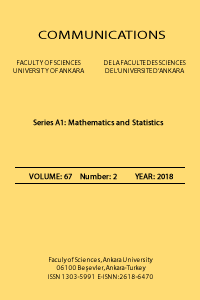Portfolio selection based on a nonlinear neural network: An application on the Istanbul Stock Exchange (ISE30)
Heuristic techniques have used frequently in portfolio optimization problem. However, almost none of these techniques used a neural network to allocate the proportion of stocks. The main goal of portfolio optimization problem is minimizing the risk of portfolio while maximizing the expected return of the portfolio. This study tackles a neural network in order to solve the portfolio optimization problem. The data set is the daily price of Istanbul Stock Exchange-30 (ISE-30) from May 2015 to May 2017. This study uses Markowitz’s Mean-Variance model. Indeed, the portfolio optimization model is quadratic programming (QP) problem. Therefore, many heuristic methods were used to solve portfolio optimization method such as particle swarm optimization, ant colony optimization etc. In fact, these methods do not satisfy stock markets demands in the financial world. This study proposed a nonlinear neural network to solve the portfolio optimization problem.
Keywords:
Portfolio optimization Nonlinear neural network, ISE-30,
___
- Markowitz, H., Portfolio Selection, Journal of finance, (1952).
- Markowitz, H., Portfolio selection efficient diversification of investment, Newyork Wiley, 1959.
- Konno, H. and Yamazaki, H., Mean absolute portfolio optimisation model and its application to Tokyo stock market, Management Science 37 (5), (1991), 519-531.
- Jorion, P.H., Value at Risk: A New Benchmark for Measuring Derivatives Risk, Chicago: Irwin Professional Publishers, 1996.
- Simaan, Y., Estimation risk in portfolio selection: The mean variance model and the mean-absolute deviation model, Management Science, 43, (1997), 1437-1446.
- Rockafellar T.R. and Uryaser S.P., Optimization of Conditional Value-at-risk, J. Risk, 2, (2000), 21-41.
- Yan, W. and Li, S., A Class of Multi-period Semi-variance Portfolio Selection with a Four-factor Futures Price Model, J. Appl. Math. Comput, 29, (2009), 19-34.
- Junhui, F., Weiguo, Z., Qian, L. and Qin, M., Nonlinear Futures Hedging Model Based on Skewness Risk and Kurtosis Risk, Systems Engineering, 27(10), (2009), 44-48.
- Konno, H. and Wijayanayake, A. Portfolio Optimization Problem Under Concave Transaction Costs and Minimal Transaction Unit Constraints, Math. Program, 89, (2001), 233-250.
- Lai, K. K., Yu, L., Shouyang, W. and Chengxiong, Z., A Double-Stage Genetic Optimization Algorithm for Portfolio Selection, International Conference on Neural Information Processing, 4234, (2006), 928-937.
- Chen, J.S. and Yaotang, L., A Partitioned Portfolio Insurance Strategy by Relational Genetic Algorithm, Lecture Notes in Artificial Intelligence, 4304, (2006), 857-866.
- Charpentier, A. and Oulidi, A., Estimating Allocations for Value-at-risk Portfolio Optimization, Mathematical Methods of Operations Research, 69, (2009), 395-410.
- Juan, C., Portfolio Optimization Algorithm for Multi Objective Programming, Xian: Xi'an Shiyou University, (2012), 16-42.
- Yutao, Q., Fang, L., Weiyuan, C., Xiaoliang, M. and Licheng, J. Memetic Immune Algorithm for Multi-objective Optimization, Journal of Software, 24(7) (2013), 1529-1544.
- Jie, C., Xiu, Y., Lan, Z., Meixia, Z. and Zhenkun, L., Microgrid Multi-objective Economic Dispatch Optimization, Proceedings of the CSEE, 33(19), (2013), 57-66.
- Yong, F., Lai, K. and Yangshou, W., A Fuzzy Mixed Projects and Securities Portfolio Selection Model, Lecture Notes in Artificial Intelligence, 3614, (2005), 931-940.
- Jiuping, X., Xiaoyang and Z., Li, S., A Class of Chance Constrained Multi-objective Portfolio Selection Model Under Fuzzy Random Environment, Journal of Optimization Theory and Applications, 150, (2011), 530-552.
- Tank, D. W. and Hopfield, J. J., Simple neural optimization networks: An A/D converter, signal decision circuit, and linear programming circuit, IEEE Transactions on Circuits and Systems, 33(5), (1986), 533-541.
- Kennedy, M.,P. and Chua, L.O., Neural network for nonlinear programming, IEEE Transactions on Circuits and Systems, 35 (5), (1988),554-562.
- Maa, C. Y. and Schanblatt, M.A., A two-phase optimization neuralnetwork, IEEE Transactions on Neural Network 3 (6), (1992), 1003-1009,.
- Zhang, S. and Constantinides, A. G., Lagrange programming neural networks, IEEE Transactions on Circuits and Systems, II 39 (7), (1992), 441-445.
- Wang, J., A deterministic annealing neural network for convex programming, Neural Networks 5 (4), (1994),962-971.
- Xia, Y., A new neural network for solving linear programming problems and its application, IEEE Transactions on Neural Networks, (1996).
- Nyguen, K.V., A Nonlinear Network for Solving Linear Programming Problem s., International Symposium on Matematical Programming, ISMP, Atlanta, GA, USA, (2000).
- Yan, Y., A new nonlinear neural network for solving QP problems. Springer International Publishing Switzerland, 347-357,(2014).
- Bohra, D. and Bhatia, S., Portfolio Return Modelling Using ANFIS, International Journal of Engineering Research & Technolog, (2012).
- Malek, A., and Yari, A., Primal' dual solution for the linear programming problems using neural networks, Applied Mathematics and Computation 167,1, (2005), 198-211.
- Malek, A., Applications of Recurrent Neural Networks to Optimization Problems. Recurrent Neural Networks In Tech., (2008).
- Yan, Y. A Nonlinear Neural Network's Stability Analysis and Its kWTA Application, International Symposium on Neural Networks, Springer, Cham, (2015).
- Xia, Y., Neural network for solving extended linear programming problems. IEEE transactions on neural networks, 8.3, (1997), 803-806.
- ISSN: 1303-5991
- Yayın Aralığı: Yılda 4 Sayı
- Başlangıç: 1948
- Yayıncı: Ankara Üniversitesi
